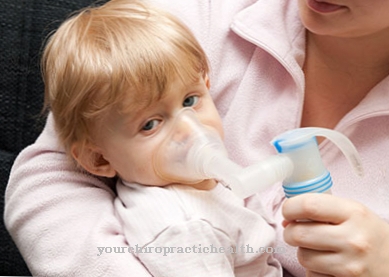From one Thrombophilia is used when there is an increased tendency to blood clots (thrombosis). It can be both congenital and acquired during life.
What is thrombophilia?

© tibanna79 - stock.adobe.com
At a Thrombophilia Affected people tend to form blood clots or thromboses in the blood vessels. There is also the risk of embolism, which is due to the changed properties of blood plasma, blood cells, vessel walls and blood flow.
Thrombophilia is either inherited or acquired during life. In Europe and the USA, about 160 out of 100,000 people develop a vein thrombosis each year. The older a person gets, the more the risk of a blood clot increases.
causes
Various causes can be considered for the development of thrombophilia. This includes u. a. the APC resistance (factor V Leiden mutation). Blood coagulation factor V (5) is an important part of the human blood coagulation system. So it belongs to the coagulation cascade.
This causes the thrombocytes (blood platelets) to clump together firmly, so that a wound can close again quickly and stably. The breakdown of factor V is also important, otherwise there is a risk of blood clots forming in other places. In such cases, there is talk of thrombophilia. Activated protein (APC) is used to inactivate factor V.
However, if there is APC resistance due to a mutation in coagulation factor V, a factor V Leiden mutation is present. Due to the mutation, factor V becomes resistant to the APC and cannot be inactivated. People between the ages of 20 and 40 are particularly affected. The risk of thrombosis is particularly high in women who take birth control pills.
Another cause of thrombophilia can be a lack of the proteins S and C be. They form the body's own inhibitors of blood clot formation. The proteins break down and inactivate special coagulation factors such as factor V and factor VIII, so that excessive blood clot formation is counteracted.
While protein C does the cleavage, protein S serves as an auxiliary enzyme. If there is a deficiency in these proteins, this leads to thrombophilia. The most common causes of the deficiency symptoms include liver disease or blood poisoning. Sometimes the deficiency is already innate.
Further genetic risk factors are a mutation of the MTHFR gene, an antithrombin deficiency, a prothrombin mutation, a heparin-induced thrombocytopenia and the formation of antiphospholide antibodies, which are produced by the body and attack its own structures.
In addition, there are also several acquired risk factors that can lead to the development of thrombophilia. These include old age, tobacco consumption, too little exercise, obesity, pregnancy, the use of estrogen-containing contraceptives, malignant diseases, heart failure and immobilization due to illnesses or surgery.
In around 40 percent of all patients who suffer from thrombophilia, no specific cause for the disease can be found. In medicine there is talk of idiopathic thrombophilia.
Symptoms, ailments and signs
The symptoms of thrombophilia vary. They depend on which vessel is narrowed or blocked. In most cases, thrombophilia is not diagnosed until a blood clot or embolism is examined. An embolism is when the arteries are blocked. This can be in the lungs, the brain or the heart.
Thrombophilia often shows up in the deep veins in the legs. It is noticeable through leg pain, discoloration of the skin and swelling. The repeated occurrence of blood clots is an indication of thrombophilia. The clots can also form in unusual body regions such as the veins in the kidneys, the intestines or the spleen, as well as in the brain vessels.
Diagnosis & course of disease
If blood clots appear more frequently, this leads the doctor to suspect that there may be thrombophilia. This is especially true if the clots appear before the age of 45 and are familial. The diagnosis of thrombophilia is made through several laboratory tests. For this purpose a blood sample is taken.
The blood sample is tested for APC resistance in a laboratory. Furthermore, the blood coagulation factors II and V, the proteins C and S and antithrombin are analyzed. Possible antibodies in the blood, which can also trigger thrombophilia, play an important role.
The course of thrombophilia depends on the particular trigger. The causes of genetic defects cannot be treated in this way. However, if the tendency to clot is detected in good time, the risk of thrombosis can usually be reduced significantly.
Complications
In the worst case, thrombophilia can lead to death. The internal organs or the brain can also be irreversibly damaged, so that the person affected suffers from disabilities after an attack. The further course of the disease depends heavily on the exact region of the blood clot and the affected organ. A general prediction of the symptoms and complications is therefore not possible.
Those affected primarily suffer from severe pain or swelling. Often the skin is also colored blue due to the lack of oxygen. If the blood clots appear on the internal organs, it can also lead to a loss of consciousness and furthermore to death of the person concerned.For this reason, immediate treatment by an emergency doctor is necessary.
The success of the treatment depends very much on the time of diagnosis of the thrombophilia. Treatment itself can be done with the help of drugs. Thrombosis stockings can also be used to alleviate the symptoms. There are usually no complications. However, the patient's life expectancy may be reduced due to the illness.
When should you go to the doctor?
A doctor should be consulted as soon as the person concerned perceives physical impairments that contribute to a reduced quality of life. Pain in the legs, circulatory disorders and irregular heartbeats should be examined and treated. If it is no longer possible for the person affected to perform their usual tasks, they must receive medical care.
Discoloration of the skin, swelling or hardening on the body must be clarified by a doctor. If the person concerned notices general dysfunction, an internal weakness or if he complains of a diffuse feeling of illness, he should consult a doctor. If he needs help with moving or if there are restrictions on the sound output, these are alarm signals from the organism. Sweating, insomnia, headache or malaise are other signs of a health disorder.
Since the affected person can suddenly die if the disease progresses unfavorably, a visit to the doctor is indicated as soon as the first irregularities occur. Persistent or increasing symptoms should be presented to a doctor as soon as possible. A doctor is required in the event of breathlessness, tightness or restrictions in movement.
In acute situations, an ambulance service should be alerted as there is danger to life. Loss of consciousness, memory impairment and behavioral problems must be examined immediately by an emergency doctor. Those present are obliged to provide first aid until the rescue service arrives.
Treatment & Therapy
In order to treat thrombophilia effectively, it is important to prevent blood clots from forming. To this end, the patient should counteract the triggering risk factors. This is especially true for congenital thrombophilias. For example, it is important to ensure sufficient exercise and to drink enough fluids on longer flights or journeys. Wearing special thrombosis stockings can also be helpful.
Some patients are also given drugs that make the blood less capable of clotting. This primarily includes the active ingredient Marcumar, which is taken in tablet form and which acts as an antagonist to vitamin K in the organism, which reduces the coagulability of the blood.
prevention
To prevent blood clots from thrombophilia, it is important to counteract the risk factors. These include reducing excess weight or giving up tobacco.
Aftercare
Those affected with thrombophilia usually have only a few and only limited follow-up measures available. For this reason, patients should consult a doctor at the first signs of the disease so that further complications can be prevented. As a rule, independent healing cannot occur, so that those affected are usually always dependent on a medical examination and treatment.
The earlier a doctor is consulted, the better the further course of the disease is usually. In many cases, patients with thrombophilia are dependent on the intake of various drugs. It is important to ensure that it is taken regularly and that the dosage is correct in order to relieve the symptoms correctly and permanently.
Consult a doctor first if anything is unclear or if you have any questions. Contact with other people affected by the disease can also be useful, as this can lead to an exchange of information on how to manage the disease more easily. In some cases, the disease can also limit the life expectancy of the person affected, whereby the further course depends heavily on the time of diagnosis and therefore a general prediction cannot be made.
You can do that yourself
People who are prone to thrombosis should have regular medical examinations. At the same time, various measures can be taken to reduce the risk of thrombosis.
First of all, it is important to adapt the lifestyle to the thrombophilia. The diet should be healthy and balanced. It is important to avoid foods that have a negative impact on the symptoms. Those affected should also exercise a lot. Endurance sports such as swimming or cycling support blood flow in the leg veins. Vein gymnastics also serves this purpose. Sports that require abrupt changes in strength, such as tennis or weightlifting, should be avoided. Foot exercises improve blood circulation and vein health. In addition, enough water should be drunk. Mineral water, tea or diluted fruit juices are suitable. Affected people should stop smoking and avoid alcohol and caffeine.
The veins should not be constricted, for example by crossing the legs or bending the knees sharply. If necessary, compression stockings must be worn. Special support stockings support the veins and prevent thrombosis. Women should consult their gynecologist about contraception, as certain drugs can increase the risk of thrombosis. A detailed consultation with the doctor is also necessary before hormone replacement therapy during menopause.

.jpg)

.jpg)
.jpg)




















.jpg)


